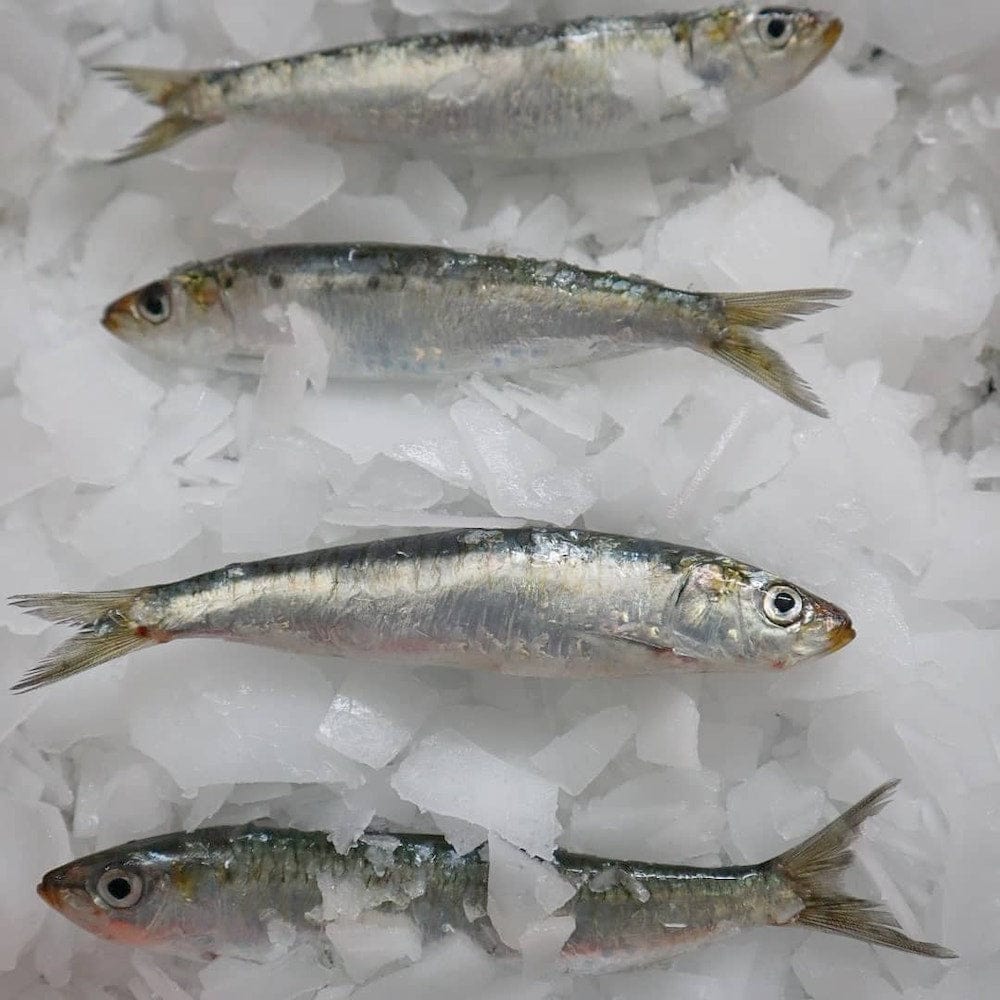Sardines were previously abundant in most oceans, simple to catch, preserve, and consume. Now, they are becoming scarce, with controlled fishing subject to quotas.
It is challenging to differentiate frozen sardines from Morocco and fresh sardines from Portugal or Brittany.

The sardine, an ancient history.
The sardine has a rich history dating back to ancient times. Between 1200 and 300 BC, the Phoenicians engaged in extensive sardine fishing, preserving them in salt. Sardines were a common food for the Egyptians, Greeks, and Romans, enjoyed either fresh or preserved in salt barrels.
During the Middle Ages, sardines were a staple across Europe, and it was later discovered that they could be preserved in vinegar, olive oil, or melted butter. The process of appertized canning was pioneered by Nicolas Appert in 1795, but it wasn't until the second half of the 19th century, following various enhancements, that this preservation method became widespread.
In Portugal, the history of sardine preservation traces back to Vila Real de Santo António in 1865, where sterilization was first utilized in a tuna processing plant owned by the Ramirez company.

Sardine cannery - Credit Fidès
In 1950, there were more than 400 canneries throughout Portugal. Today, there are still 14 that stand out for the quality of their production due to the freshness of the sardines and the production methods that have remained artisanal.

Old fishing boat on the beach of Nazaré - Credit unknown
In Portugal, the canneries are strategically clustered around six prominent fishing ports: Matosinhos, in proximity to Porto; Peniche, situated between Porto and Lisbon; Sesimbra and Setúbal, located to the south of Lisbon; and Portimão and Olhão in the southern part of Portugal.
All these canneries are positioned in close proximity to these ports and exclusively process exceptionally fresh sardines. Some of them operate without the need for cold storage facilities.
Importantly, there is no consideration given to utilizing frozen sardines from Morocco in this region. Moreover, given the inherent fatty nature of sardines, freezing is generally not a preferred method of preservation.

Map of Portuguese canneries - Credit Publico
In an era where artisanal fishing contends with industrial practices, and dwindling species necessitate stricter quotas, amidst escalating international competition and the relentless pressure on prices demanding enhanced productivity... how does one discern the finest quality canned sardines?
Check the origin of sardines.
The term "sardine" is frequently misapplied to refer to approximately twenty different types of small fish: sardinella, sardinops, sprats, anchovies, herrings, among others, each possessing distinct tastes and characteristics.
The authentic sardine is identified as "Sardina pilchardus" a species that inhabits coastal areas and forms occasionally dense schools, typically found between 10 and 50 meters beneath the surface.

Sardina pilchardus - Credit Papa Anzóis
The "Sardina pilchardus" is found in the Mediterranean but especially in the North Atlantic Ocean from Ireland to the Azores through France, Portugal and Morocco.
Check the origin of the fish.
Presently, the challenge facing canneries that uphold a legacy of excellence lies in the scarcity of the "pilchardus" species and the subsequent reduction in fishing quotas.
The optimal time for catching Sardina pilchardus spans from early May to late October. Beyond these dates, the fish either lack sufficient fat content or are in a spawning period.

Hence, these canneries are entirely reliant on Portuguese fishing grounds and adamantly decline to seek alternative sources, mindful of the potential compromise in the quality of their production.
Check the canning method .
Upon returning from the fishing boats, the freshly caught sardines undergo scaling and gutting, followed by pre-cooking in oil or steam. Subsequently, the selected sardines are meticulously arranged into their cans by hand. The cans are then filled with high-quality olive oil and sealed through crimping.

Papa Anzóis canning
All these procedures are executed manually, ensuring the meticulous selection, preparation, and placement of sardines in their cans. The automation of these processes, along with the utilization of frozen sardines, significantly diminishes the quality of the canned sardines in terms of both taste and texture.
Sardines or sardine fillets?
The sardines undergo preparation before the cooking process, involving the removal of their heads, gutting, and the elimination of fins. All these tasks are performed manually and are reiterated post-cooking, just before the ultimate canning stage.
This meticulous approach ensures the preservation of the skin and bones. Some argue that this is crucial as it contributes to better-preserved sardine flavor and a higher calcium intake. Over the course of a few months, the skin and bones gradually diminish, nearly melding into the flesh.
Sardines in olive oil José Gourmet - Luisa Paixão collection
However, some individuals find the inclusion of skin and bones unappealing. Consequently, there are canned sardine fillets available that are devoid of skin and bones.
These fillets are slightly pricier due to the more extensive handling involved, but they ensure that the can only contains the flesh of the sardine fillets.
Sardines or small sardines?
Typically, the cans are designed to accommodate four sardines, precisely calibrated to fill the can completely. I recommend exploring the Portuguese "petingas" — smaller sardines arranged in sets of six within a can. While taste is subjective, I find them to be more flavorful and tender.
Olive oil or vegetable oil?
Gourmets assert that the finest canned sardines are those prepared in olive oil, specifically "trimmed in white," as it is the white belly of the sardine that is visually presented, appealing to the eye.
Sardines in olive oil dressed with white Ati Manel - Luisa Paixão collection
Others have a preference for sardines in vegetable oil. Ultimately, it comes down to personal taste. The fragrance of olive oil tends to blend with that of the sardine, whereas vegetable oil is believed to better preserve the authentic taste of the fish.
Canned sardines in sauce ?
Gourmets highly recommend sardines preserved simply with olive oil, yet there are numerous other delectable preparations waiting to be explored.
Certainly, you can readily find canned sardines featuring a fillet or a slice of lemon, as well as options with a straightforward tomato sauce or spiced up with Portuguese piri-piri.
Canned sardines with tomato José gourmet - Luisa Paixão collection
I also encourage you to explore sardine preserves known as "à l'escabèche," featuring a marinade crafted with oil, vinegar, bay leaves, parsley, tomato puree, and garlic. Additionally, there are preserves prepared with olive oil and curry, olive oil and red peppers, pepper, oregano, pickles, and more. These diverse options make for ideal variations to enhance your appetizer experience.
Should sardine cans be left to age?
The current regulations naturally apply to canned sardines, and no vendor is permitted to sell canned goods beyond their use-by date. Typically, this deadline is set at around 2 years after the sardines are canned.
However, there is a unique characteristic to sardine cans – they tend to improve with age. Over time, an osmosis occurs between the fish and the oil. Some individuals even appreciate sardines after seven or eight years, often turning the cans over every six months (although this practice is unnecessary and stems from historical habits when cans were not completely filled). A truly exceptional can of sardines is one that has aged gracefully.
What about vintage sardines?
The term "vintage" sardines is essentially a marketing creation. In reality, it signifies that the canned sardines come from the same fishing season, a common practice for all canned sardines in Portugal.
Conversely, an industrial producer using frozen sardines from Morocco, all harvested during the same fishing season and frozen simultaneously, can label their production as "vintage sardines," a somewhat ironic twist.
Frequently, our customers request these so-called vintage sardines, often having encountered them at friends' homes or in restaurants. Unfortunately, we cannot sell canned sardines beyond their use-by date, even if they might improve with age, as it is prohibited by legislation. However, there's nothing preventing you from storing your preserves for a few years for a future tasting experience.
Sardines are excellent for your health.

Sardines are an excellent source of proteins, serving as a vital energy source for the human body. While they contain 10 to 12% lipids, what sets them apart is the notably high proportion of Omega-3 fatty acids. These fatty acids play a crucial role in restoring the balance between Omega-6 and Omega-3 fatty acids, thereby reducing the risk of cardiovascular diseases.

In addition to proteins and Omega-3 fatty acids, sardines are rich in essential vitamins and nutrients. They provide a valuable source of calcium, phosphorus, and selenium, known for its antioxidant properties. Sardines also contain vitamin D and various B-group vitamins, including vitamin B3, which plays a role in regulating cholesterol and triglyceride levels.
The sardine, being a small fish positioned at the base of the food chain, does not accumulate various pollutants and is considered a non-bioaccumulative fish. This characteristic makes it a relatively low-risk option in terms of environmental pollutants.
Will canned sardines become a rare commodity? Consumers don't always realize when they open a can of sardines that this product may soon become a luxury item.
Discover 120 different canned Portuguese fish products






